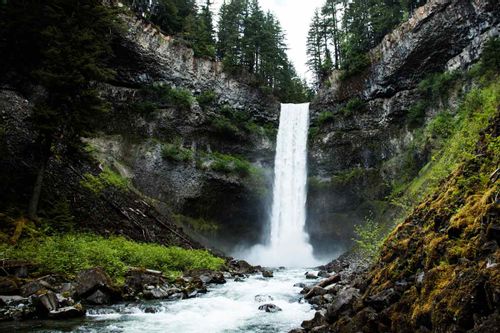FOR ALL AGES
The natural world is a fascinating place: as our African Elephant Facts and Mantis Shrimp Facts blogs show, from the biggest to the smallest, there's always something new to discover about the wildlife we share our planet with.
Think of woods in fall and you'll almost certainly imagine a fluffy-tailed squirrel scampering around through the trees stashing nuts to keep it going through the winter ahead. But there's much more to know about these adorable little rodents than just storing food and scrambling up tree trunks.
Red squirrels live all over the world. From the classic English red squirrel that pops up on Christmas cards every winter to Switzerland's black "red" squirrels, the world is full of these fluffy-tailed critters. To keep track of them all, scientists have come up with a system called taxonomy which shows how closely related different animals are. Its system of kingdom, phylum, class, order, family, genus, species shows how different animals relate to each other.
No matter how they're related, we think all those nutty little squirrels are fascinating. We've compiled a list of the most intriguing, unexpected and downright weird facts about the red squirrel population around the world to show everyone they're more than just a fluffy tail.
Fabulous facts about special squirrels from all over the world.
1. Red squirrels, like rabbits, mice, hamsters and many other creatures, are a type of rodent. This means their front teeth keep growing continuously throughout their lives.
2. There's more than one kind of red squirrel. The American red squirrel, Tamiasciurus hudsonicus, is a type of pine squirrel, while Eurasian red squirrels are part of the genus Sciurus, or tree squirrels.
3. Almost all the different types of red squirrels have reddish or brownish-gray fur over most of the body with a white chest and stomach. However, some species can have fur that shades from red all the way through to black.
4. The average red squirrel life span in the wild is 3 years, although some have been known to live as long as ten years.
5. Squirrels' big fluffy tails don't just make them look adorable. They help the squirrel balance as it runs through the trees, and when fluffed up and flicked around, it's also used to warn other squirrels not to mess with its owner.
6. Squirrels' tails take up about half their body length. On average, a red squirrel is usually about 12 inches long, and its tail takes up about 6 inches of that.
7. In winter, squirrels use their tails like a big fluffy blanket to help them keep warm.
8. Red squirrels' ankles are double-jointed. They can turn their feet round so that their claws grip the bark of the tree no matter whether they're going up or down.
9. In the fall of each year, red squirrels gain as much as 12% of their body weight in winter fat reserves.
10. The gray squirrel can carry a virus called squirrel parapoxvirus, which doesn't make them sick but can kill red squirrels. This is one reason why red squirrel populations decrease when gray squirrels are around.
Food for thought! Find out more about what squirrels munch on when they get bored with the typical acorns.
11. Red squirrels spend 60-80% of the time they're awake either looking for food or eating.
12. American red squirrels eat mainly spruce and pine cones, while Eurasian red squirrels' diet contains more seeds and nuts.
13. Up to 50% of a pine squirrel's diet can be white spruce seeds. They collect the cones and store them in a shared pile to eat later.
14. After they eat, pine squirrels drop the leftover bits of cone into a trash heap called a midden. These can grow up to 42 feet across. That is a lot of leftovers!
15. When you think of a red squirrel, you probably imagine it nibbling on a nut, but the red squirrel diet is really much more varied. As well as pine cones and spruce seeds, red squirrels also eat spruce needles, fungi, leaves, catkins, flowers, berries, and even bird eggs.
16. Both American and Eurasian red squirrels are great at storing food. They use holes in the ground or cavities in trees as "pantries" and stock them with all the things red squirrels eat, like nuts, seeds, pine cones, fungi, and berries.
17. Some smart squirrels even lay their mushrooms out to dry before they store them, to make sure they don't spoil over the winter.
18. Red squirrels are clever enough to know if their food is bad before they even open it. They'll shake a nut before cracking it open, and if they hear a rattle, they know the nut is past its best.
19. Squirrels and their habit of burying food plays an important part in making sure the forest is still full of trees. Forgotten squirrel stashes sprout into saplings come spring and summer, helping create habitats for more wildlife.
20. In the UK, people who leave seeds out for the birds in winter are often dismayed to find all the food has been stolen by cheeky squirrels! Bird food theft is so common that shops have even started selling special squirrel-proof bird feeders.

From where they sleep to what they look like when they're born, find out all about the daily life of a squirrel.
21. Most squirrels are diurnal, which means they're awake during the day and sleep at night.
22. Squirrels don't hibernate. Instead, they stay awake year-round. They're just less active in the winter because the cold weather makes them stay in their nests conserving energy and sheltering from the cold.
23. Red squirrels like to nap. They're active in the morning and late afternoon to evening, but sleep in the middle of the day.
24. The ideal red squirrel habitat is woodland with plenty of nuts, seeds, fungi and berries available. A common habitat is coniferous forests as well as deciduous woods across North America and Europe.
25. A red squirrel nest is called a drey. Squirrels make their dreys in trees using grass or twigs.
26. Red squirrels have second (and third) homes. Female squirrels like to make several nests in different trees and move their young between them every so often.
27. Look out for young red squirrels in spring and summer. Female red squirrels can have two litters of young in a year, one between February and April and another in May or June.
28. A litter of red squirrels can have anywhere between one to five young, although three is the average. This means a female red squirrel can give birth to as many as ten kits in a year.
29. When they're born, young squirrels weigh just 0.35 ounces. They're also hairless and blind at birth.
30. Young red squirrels are called kittens or kits. They become independent at around ten weeks old.
31. It might look cute when two squirrels chatter and stamp around on the ground, but don't be fooled - this is how squirrels argue. If you see squirrels acting like this, someone has probably been trespassing on someone else's territory.
The North American red squirrel, Tamiasciurus hudsonicus, is as unique as it is cute. Learn more about red squirrels' habitat, diet, and more with these absolutely nuts red squirrel facts.
32. Canada was the first place North American red squirrels were recorded. The squirrel's Latin name, Tamiasciurus hudsonicus, comes from the fact that Erxleben, the scientist who recorded them, first spotted them in Hudson's Bay.
33. American red squirrels are native to North America, including Canada and Alaska as well as some other areas of the United States.
34. Although "it's red squirrel vs gray squirrel and they can't live together" is one of the best known red squirrel facts, Massachusetts is home to a population of both. Unlike their Eurasian counterparts, American red squirrels don't struggle to live alongside grays, so they get along just fine.
35. North American red squirrels are one of three species of tree squirrels known as pine squirrels. The other two are the Douglas squirrel and Mearns's squirrel.
36. These squirrels are called pine squirrels because they live in coniferous forests and eat the trees' seeds.
37. The Mount Graham red squirrel is a tiny species from Arizona which is just 8 inches long. It was thought to have gone extinct in the 1950s. Thankfully it's been rediscovered in recent years, but the population size is small and it's on the endangered list.
38. Pine squirrels have a lot of predators among North America's wildlife population, including lynx, coyotes, bobcats, foxes, wolves and birds of prey.
39. They may be adorable, but squirrels can be destructive. They sometimes make their nests in the attics of houses instead of in trees, where they get up to all kinds of antics like chewing through electrical wires and tearing up loft insulation.

Learn all about the Eurasian red squirrel, Sciurus vulgaris, with its big fluffy tail, adorable ear tufts and constant battle to stay one step ahead of its gray squirrel rivals with these Scottish red squirrel facts.
40. Eurasian red squirrels are easily recognised by their ear tufts, which gray squirrels don't have, and red fur. However, there is a type of Eurasian red squirrel living in Austria and Switzerland which has a black coat.
41. Eurasian red squirrels are found all the way across northern Europe, from the UK and Ireland to Mongolia and Russia.
42. Eurasian red squirrels have separate summer and winter coats. Their summer coats are lighter while their winter coats are thicker and darker, with bigger ear tufts.
43. Out of 350 squirrel species worldwide, the Eurasian red squirrel is the only one native to Scotland and the rest of the UK.
44. According to the IUCN Red List for the UK released this year, Eurasian red squirrels' population size is so small that they're now an endangered species.
45. The biggest population of red squirrels in the UK is in Scotland. Out of the 160,000 remaining red squirrels in the UK, 120,000 of them are found in Scotland, where they face less competition from gray squirrels.
46. Thanks to years of effort by conservation groups, the red squirrel population in Scotland is starting to recover in some areas. In fact, even though the squirrel is on the red list in the UK, it's quite common locally in Scotland.
47. Although the decreasing red squirrel population in the UK is often blamed on the gray squirrel, red squirrels are also a victim of the habitat loss which has affected a lot of the British wildlife population.
Among the hundreds of animals and birds in the Amazon rainforest are even more red squirrels. Learn all about the exotic Amazon red squirrel with these fab facts.
48. There are two kinds of red squirrel living in the Amazon: the northern Amazon red squirrel, or Sciurus igniventris, and the southern Amazon red squirrel, Sciurus spadiceus.
49. Both Northern and Southern Amazon red squirrels live in the rainforests of Columbia, Peru, Brazil and Ecuador. Only northern Amazon squirrels live in Venezuela, while only Southern ones live in Bolivia.
50. Unlike most squirrels, Amazon red squirrels spend most of their time on the ground, although they can still climb trees when they need to.
51. Unlike many species of wildlife in the Amazon, the IUCN Red List categorizes red squirrels as Least Concern, meaning they're still thriving.
52. If you hear a sneeze in the trees, you probably scared a squirrel. When Amazon squirrels are startled, they make alarm calls to alert other squirrels which is said to sound a lot like a sneeze.
53. To tell the difference between the two types of Amazon red squirrels, look at the fur on the tops of the feet and behind the ears. On Southern Amazon squirrels, it's orange.
With its enormous size (for a squirrel anyway) and ability to glide between trees, there's plenty to find out about these giant squirrels.
54. Red giant flying squirrels are native to Southeast Asia, the Himalayas and southern China and is nocturnal, meaning it's mainly active at night.
55. The red giant flying squirrel is one of the longest squirrels in the world, at a whopping 1 foot and 9 inches long.
56. The red giant flying squirrel doesn't really fly. It glides from tree to tree by spreading out a fold of skin between its limbs. It can glide about 300-500 feet at a time, although glides as long as 1480 feet have been reported.
57. Female red giant flying squirrels give birth to litters of one or occasionally two young each year.
58. Red giant flying squirrels' diet is mostly leaves, although they will also eat flowers, fruit, nuts, seeds and bark.
59. If you hear a spooky sound at dusk in Southeast Asia, it might just be a red giant flying squirrel. Their call is said to sound like a "drawn-out wail" or a "whine".
Facts about squirrels you'd have to be out of your tree not to want to know.
60. People in Finland used to use squirrel furs to buy and sell things before they started using money.
61. Beatrix Potter's book 'Squirrel Nutkin' follows the adventures of a cheeky red squirrel as he tries to outwit an owl.
62. In Norse mythology, a red squirrel called Ratatoskr runs up and down the world tree Yggdrasil, carrying messages between an eagle who lives at the top and a dragon who lives in the roots.
63. Red squirrels are the national animals of Denmark.
64. Squirrels have their very own day. 21 January is Squirrel Appreciation Day.
65. New Zealand is not a fan of the squirrel. Red squirrels are classed as a "prohibited new organism", which means it's illegal to bring them into the country.
66. There are a lot of partly-red squirrel species, like the red-tailed squirrel native to South and Central America, China's red-hipped squirrel and the red-cheeked squirrel in Asia.
Here at Kidadl, we have carefully created lots of interesting family-friendly facts for everyone to enjoy! If you liked our suggestions for 66 Red Squirrel Facts That Are Sweet As A Nut, then why not take a look at Fox Facts For Kids, or Bats For Kids.
Read The Disclaimer
At Kidadl we pride ourselves on offering families original ideas to make the most of time spent together at home or out and about, wherever you are in the world. We strive to recommend the very best things that are suggested by our community and are things we would do ourselves - our aim is to be the trusted friend to parents.
We try our very best, but cannot guarantee perfection. We will always aim to give you accurate information at the date of publication - however, information does change, so it’s important you do your own research, double-check and make the decision that is right for your family.
Kidadl provides inspiration to entertain and educate your children. We recognise that not all activities and ideas are appropriate and suitable for all children and families or in all circumstances. Our recommended activities are based on age but these are a guide. We recommend that these ideas are used as inspiration, that ideas are undertaken with appropriate adult supervision, and that each adult uses their own discretion and knowledge of their children to consider the safety and suitability.
Kidadl cannot accept liability for the execution of these ideas, and parental supervision is advised at all times, as safety is paramount. Anyone using the information provided by Kidadl does so at their own risk and we can not accept liability if things go wrong.
Kidadl is independent and to make our service free to you the reader we are supported by advertising.
We hope you love our recommendations for products and services! What we suggest is selected independently by the Kidadl team. If you purchase using the buy now button we may earn a small commission. This does not influence our choices. Please note: prices are correct and items are available at the time the article was published.
Kidadl has a number of affiliate partners that we work with including Amazon. Please note that Kidadl is a participant in the Amazon Services LLC Associates Program, an affiliate advertising program designed to provide a means for sites to earn advertising fees by advertising and linking to amazon.
We also link to other websites, but are not responsible for their content.
Was this article helpful?



Browse Category

We’ll send you tons of inspiration to help you find a hidden gem in your local area or plan a big day out.



Check your inbox for your latest news from us. You have subscribed to:
Remember that you can always manage your preferences or unsubscribe through the link at the foot of each newsletter.